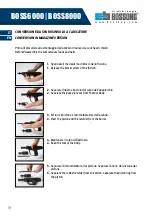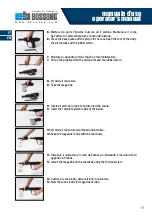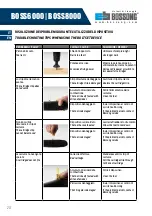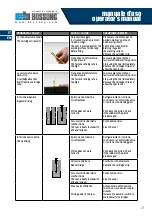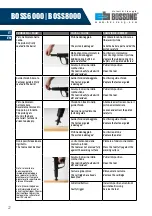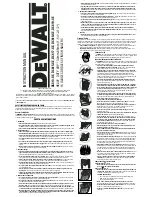
BOSS6000 | BOSS8000
s i s t e m i d i f i s s a g g i o
®
w w w . b o s s o n g . c o m
10
IT
EN
FISSAGGIO
A causa delle diverse resistenze e durezze
superficiali del calcestruzzo e delle diverse tipologie
e spessori di acciaio, il fissaggio su questi materiali
richiederà l’utilizzo di diverse potenze di sparo.
Usando l’apparecchio l’operatore ha la possibilità
di regolare la potenza dello sparo tramite la
rotella di regolazione di potenza posta sul lato
della chiodatrice a seconda del tipo di fissaggio
da eseguire. La corretta potenza di sparo è dettata
dall’esperienza e necessita di un numero di colpi di
prova per essere regolata. Il primo sparo di prova
dovrà essere eseguito con la potenza minima per
poi essere incrementata fino alla potenza che
soddisfi il grado di penetrazione desiderato.
MINIMO INTERASSE: I chiodi non dovranno essere
fissati ad una distanza inferiore agli 80 mm l’uno
con l’altro in calcestruzzo. Quando il fissaggio viene
eseguito su acciaio rispettare un interasse minimo
di almeno 20 mm.
MINIMA DISTANZA DAL BORDO: Quando i chiodi
sono inseriti in calcestruzzo mantenere una
distanza di almeno 80 mm. Quando i chiodi
vengono sparati in elementi di acciaio mantenere
una distanza dal bordo di almeno 20 mm.
SPESSORE MINIMO DEL MATERIALE BASE: Per il
fissaggio in materiale base calcestruzzo min. 80
mm, per il fissaggio in acciaio min. 5 mm.
NON ESEGUIRE IL FISSAGGIO IN ACCIAI CON
SPESSORE INFERIORE AL DIAMETRO DEL GAMBO
DEL CHIODO.
Il fissaggio dovrà essere sempre visibile dopo lo
sparo.
È tassativamente vietato usare l’apparecchio
per eseguire fissaggi di tegole, mattoni forati,
ceramica, granito, vetro, elementi in acciaio con
elevata durezza superficiale.
NON ESEGUIRE MAI FISSAGGI IN MATERIALI
FORATI. NON ESEGUIRE FISSAGGI ATTRAVERSO
SALDATURE DI SUPERIFICI.
LA CANNA DELL’APPARECCHIO DOVRÀ ESSERE
SEMPRE PERPENDICOLARE ALLA SUPERIFICE DI
LAVORO.
NON SPARARE MAI SENZA CHIODI, POTREBBE
CAUSARE DANNEGGIAMENTI ALL’ATTREZZO.
NON SPARARE MAI IN FORI.
FASTENING
Because of differences in hardness of concrete and
thickness of steel, fastenings to these materials
requires different strength of power.
Using the tool you have the possibility of regulate
the power by turning the hand wheel until the
resistance of required power is reached.
The proper power selection is the matter of
experience and needs a number of trial fastenings.
The first test should be made with the lowest
power, and then power should be increased until
desired penetration is reached.
MINIMUM CENTRE DISTANCE: nails should be fixed
with a distance not less than 80 mm the one
from the other in concrete. For fixing on steel the
minimum distance should be at least of 20 mm.
MINIMUM EDGE DISTANCE: When nails are fixed
into concrete keep a distance of at least 80 mm.
When nails are shot into steel keep an edge distance
of at least 20 mm.
MINIMUM THICKNESS OF THE BASE MATERIAL: For
fixings into concrete min. 80 mm, for fixings into
steel min 5 mm.
DO NOT FASTEN INTO STEEL THINNER THAN THE
FASTENER SHANK DIAMETER.
The fixing will be visible after the shoot.
To eliminate spalling and during work with the
single shoot version, a Spall Shield should be used.
You should not use your tool to do fastenings into
roof tiles, hollow bricks, glazing bricks, surface-
hardened steel. It is forbidden to use the tool for
fixing fragile material, even if is hard, such as cast
iron, hardened steel, marble, granite, glass, ceramic
material, drilled bricks, etc.
NEVER DO FASTENINGS INTO PERFORATED OR
BRITTLED MATERIAL. NEVER DO FASTENINGS INTO
WELDED SURFACES.
ALWAYS POINT THE TOOL PERPENDICULAR TO
THE WORK SURFACE.
NEVER FIRE THE TOOL WITHOUT FASTENER - IT
MAY DAMAGE THE TOOL.
NEVER FIRE INTO A HOLE.


















